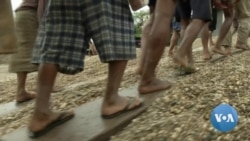ກະຊວງຮັກສາຄວາມປອດໄພພາຍໃນຂອງສະຫະລັດ ກໍາລັງເບິ່ງວິທີທີ່ປັນຍາປະດິດສາມາດເອົາມາໃຊ້ເພື່ອຊ່ວຍລະບຸສິນຄ້າ ທີ່ຜະລິດໂດຍເດັກນ້ອຍ ຫຼື ແຮງງານທີ່ຖືກບັງຄັບ ແລະເພື່ອປ້ອງກັນບໍ່ໃຫ້ສິນຄ້າເຫລົ່ານັ້ນ ເຂົ້າມາໃນປະເທດໄດ້. Julie Taboh ນັກຂ່າວວີໂອເອ ມີລາຍລະອຽດເພີ່ມເຕີມ ຊຶ່ງບົວສະຫວັນ ຈະນຳມາສະເໜີທ່ານໃນ ອັນດັບຕໍ່ໄປ.
ໃນແຕ່ລະປີ ມີຫຼາຍລ້ານຄົນໃນທົ່ວໂລກຖືກບັງຄັບໃຫ້ເຮັດວຽກຢູ່ໃນສະພາບທີ່ເປັນການອອກແຮງງານທີ່ຖືກຂົ່ມເຫັງ.
ໃນນັ້ນລວມມີເດັກນ້ອຍ 160 ລ້ານຄົນ ທີ່ມີອາຍຸລະຫວ່າງ 5 ຫາ 17 ປີ, ອີງຕາມ ຕົວເລກຫລ້າສຸດຈາກອົງການແຮງງານສາກົນ ແລະອົງການຢູນີເຊັຟ (UNICEF).
ເພື່ອແກ້ໄຂຄວາມກັງວົນເພີ່ມຂຶ້ນທີ່ວ່ານີ້ ລັດຖະມົນຕີກະຊວງຮັກສາຄວາມປອດໄພ ພາຍໃນສະຫະລັດ, ທ່ານອາເລຮານໂດຣ ມາຍຢໍຄັສ Alejandro (Mayorkas) ໄດ້ໃຫ້ຄະນະສະເພາະກິດໃຫມ່ ຄົ້ນຄວ້າຫາວິທີທີ່ຈະໃຫ້ປັນຍາປະດິດ ຫລື AI ສາມາດ ຊ່ວຍກວດຫາ ແລະປ້ອງກັນສິນຄ້າທີ່ຜະລິດຈາກການບັງຄັບໃຊ້ແຮງງານບໍ່ໃຫ້ເຂົ້າມາໃນສະຫະລັດໄດ້.
ທ່ານອາເລຮານໂດຣ ມາຍຢໍຄັສກ່າວວ່າ: "ພວກເຮົາຈະຊອກຫາວິທີທີ່ນໍາໃຊ້ AI ເຂົ້າໃນການກວດສອບສິນຄ້າ ທີ່ມີຄວາມສາ ມາດກວດສອບໄດ້ຫລາຍຂຶ້ນ, ລະບຸການນໍາເຂົ້າສິນຄ້າທີ່ຜະລິດດ້ວຍ ແຮງງານທີ່ຖືກບັງຄັບ, ແລະຄຸ້ມຄອງຄວາມສ່ຽງ."
ການແກ້ໄຂບັນຫາຢູ່ແຫຼ່ງທີ່ມາຂອງມັນ ຈະເປັນການຊ່ວຍເຫຼືອອັນໃຫຍ່ຫຼວງ, ອີງຕາມທ່ານນາງເທຍ ລີ (Thea Lee), ຮອງລັດຖະມົນຕີຊ່ວຍວ່າການກະຊວງແຮງງານສະຫະລັດ ທີ່ຮັບຜິດຊອບວຽກງານສາກົນກ່າວ.
ທ່ານນາງໄດ້ໂອ້ລົມກັບວີໂອເອຜ່ານທາງ Skype ວ່າ: "ສະນັ້ນ ຕົວຢ່າງເຊັ່ນ ການເບິ່ງໂລຫະໂຄບອລທ໌ (cobalt) ທີ່ອາດຈະຖືກຂຸດຂຶ້ນມາຈາກບໍ່ທີ່ຢູ່ໃນສາທາລະນະລັດປະຊາທິປະໄຕຄອງໂກ: ບ່ອນທີ່ວ່າ ຈາກທີ່ນັ້ນ ໃນທີ່ສຸດມັນກໍຖືກປ່ຽນ ໄປເປັນໝໍ້ໄຟລິທຽມ-ໄອອອນ (lithium-ion) ທີ່ສາກຄືນໄດ້ໃນປະ ເທດຈີນ ແລະ ຫຼັງຈາກນັ້ນ ກໍເອົາໄປໃສ່ໃນຫມໍ້ໄຟຂອງລົດໄຟຟ້າທີ່ພວກເຮົາມັກຈະພົບເຫັນຢູ່ໃນລົດຍົນ ໃນສະຫະລັດແມ່ນບໍ່?”
ເຖິງແມ່ນວ່າ AI ອາດຈະເປັນປະໂຫຍດ ແຕ່ພວກນັກຊ່ຽວຊານກໍເຕືອນວ່າ ມັນຍັງບໍ່ທັນສະແດງໃຫ້ເຫັນເທື່ອວ່າ ບໍ່ໄດ້ເປັນອັນຕະລາຍ ແລະຈໍາເປັນຍັງຕ້ອງໄດ້ປະຕິບັດຢ່າງລະມັດລະວັງຢູ່.
ທ່ານແອລເລັນ ຈີນາ (Allen Gina) ເປັນອະດີດຜູ້ຊ່ວຍຜູ້ກວດການຢູ່ຫ້ອງການດ່ານ ພາສີ ແລະປົກປ້ອງຊາຍແດນສະຫະລັດ ຫລື CBP ແລະປັດຈຸບັນເປັນຄູ່ຮ່ວມງານ ຂອງບໍລິສັດ CT Strategies. ທ່ານໄດ້ໂອ້ລົມກັບວີໂອເອຜ່ານທາງ Skype ວ່າ:
"ໂດຍທີ່ເຄີຍໄດ້ເຮັດວຽກຢູ່ CBP ມາກ່ອນ ຂ້າພະເຈົ້າຮູ້ສຶກຕື່ນເຕັ້ນຫຼາຍກ່ຽວກັບ ສິ່ງທີ່ເຄື່ອງຈັກຮຽນຮູ້ ແລະປັນຍາປະດິດສາມາດນໍາມາ ໃນເລື້ອງຕ້ານການນໍາສິນ ຄ້າເຂົ້າມາແຜ່ຜາຍຢູ່ໃນສະຫະລັດທີ່ຜະລິດ ຫຼື ເຮັດໂດຍການບັງຄັບໃຊ້ແຮງງານ ຫຼື ແຮງງານເດັກ."
ທ່ານຈີນາ ກ່າວຜ່ານທາງ SKYPE ອີກວ່າ:
“ຂ້າພະເຈົ້າຮູ້ດີວ່າ ມັນຕ້ອງໄດ້ຮຽນຮູ້ສະພາບແວດລ້ອມ. ແລະໃນເວລາທີ່ທ່ານພະ ຍາຍາມທີ່ຈະຮຽນຮູ້ສະພາບແວດລ້ອມເຊັ່ນຈີນ, ແລະຮູ້ວ່າມັນຍາກທີ່ຈະໄດ້ຮັບຂໍ້ມູນ ທີ່ຖືກຕ້ອງມາຈາກປະເທດຈີນ, ໃຜຈະກວດສອບໄດ້ວ່າ ຂໍ້ມູນທີ່ຮຽນຮູ້ໂດຍປັນຍາ ປະດິດອັນນີ້ ຖືກຕ້ອງແທ້ຫລືບໍ?”
ສິ່ງທີ່ຕ້ອງການ ທີ່ນອກເຫນືອໄປຈາກເທັກໂນໂລຈີແລ້ວ ກໍແມ່ນຄວາມຍິນດີ, ທ່ານນາງເທຍ ລີເວົ້າ.
ທ່ານນາງເທຍ ລີ ຈາກກະຊວງແຮງງານສະຫະລັດກ່າວຜ່ານ SKYPE ວ່າ:
"ພວກເຮົາຕ້ອງການໃຫ້ລັດຖະບານ ແລະບໍລິສັດຍິນດີ ທີ່ຈະດໍາເນີນຂັ້ນຕອນເພື່ອໃຫ້ມີກົດຫມາຍຮອງຮັບ ແລະການບັງຄັບໃຊ້ມັນ ແລະມີການຄວບຄຸມມັນ."
ຄະນະສະເພາະກິດ AI ມີກໍານົດທີ່ຈະລາຍງານການຄົ້ນພົບຂອງເຂົາເຈົ້າຕໍ່ກະຊວງຮັກສາຄວາມປອດໄພພາຍໃນປະເທດ ໃນຊຸມເດືອນຂ້າງຫນ້ານີ້.
ອ່ານລາຍງານນີ້ເພີ້ມເປັນພາສາອັງກິດຢູ່ລຸ່ມນີ້:
The U.S. Department of Homeland Security is looking at how artificial intelligence can be used to help identify goods made with child or forced labor and to prevent them from entering the country. VOA’s Julie Taboh has more.
Each year, millions of people worldwide are forced to work in abusive labor conditions.
That includes 160 million children between the ages of 5 and 17, according to the latest numbers from the International Labor Organization and UNICEF.
To address this growing concern, U.S. Homeland Security Secretary Alejandro Mayorkas has a new task force to explore ways artificial intelligence might help detect and prevent goods made from forced labor from entering the United States.
Alejandro Mayorkas, US Homeland Security Secretary: “We will seek to deploy AI to more ably screen cargo, identify the importation of goods produced with forced labor, and manage risk.”
Tackling the problem at its source would be a big help, says Thea Lee, U.S. Department of Labor deputy undersecretary for international affairs.
She spoke with VOA via Skype:
“So, for example, looking at cobalt that might be mined in the Democratic Republic of Congo: Where does that end up being transformed into lithium-ion batteries in China and then put into electric vehicle batteries that we would find in cars in the United States?”
While AI may be helpful, experts warn it’s not yet foolproof and needs to be deployed with caution.
Allen Gina is a former assistant commissioner at U.S. Customs and Border Protection ((CBP)) and currently a partner at CT Strategies. He spoke with VOA via Skype.
Allen Gina, Former US Customs and Border Protection Assistant Commissioner.
“Having previously worked at CBP, I'm very excited about what machine learning and artificial intelligence can bring in combating the introduction of items into the United States manufactured or produced by forced labor or child labor.”
Allen Gina, Former US Customs and Border Protection Assistant Commissioner via SKYPE:
“I do know it has to learn the environment. And when you're trying to learn an environment such as China, and knowing how difficult it is getting accurate information out of China, who's going to validate that the information that's being learned by this artificial intelligence is in fact accurate?”
What is needed in addition to technology is the will, says Thea Lee.
Thea Lee, US Department of Labor via SKYPE: “We need governments and companies being willing to take the steps to put in place laws and enforce them and regulate them.”
The AI task force is due to report its findings to Homeland Security in the coming months.





